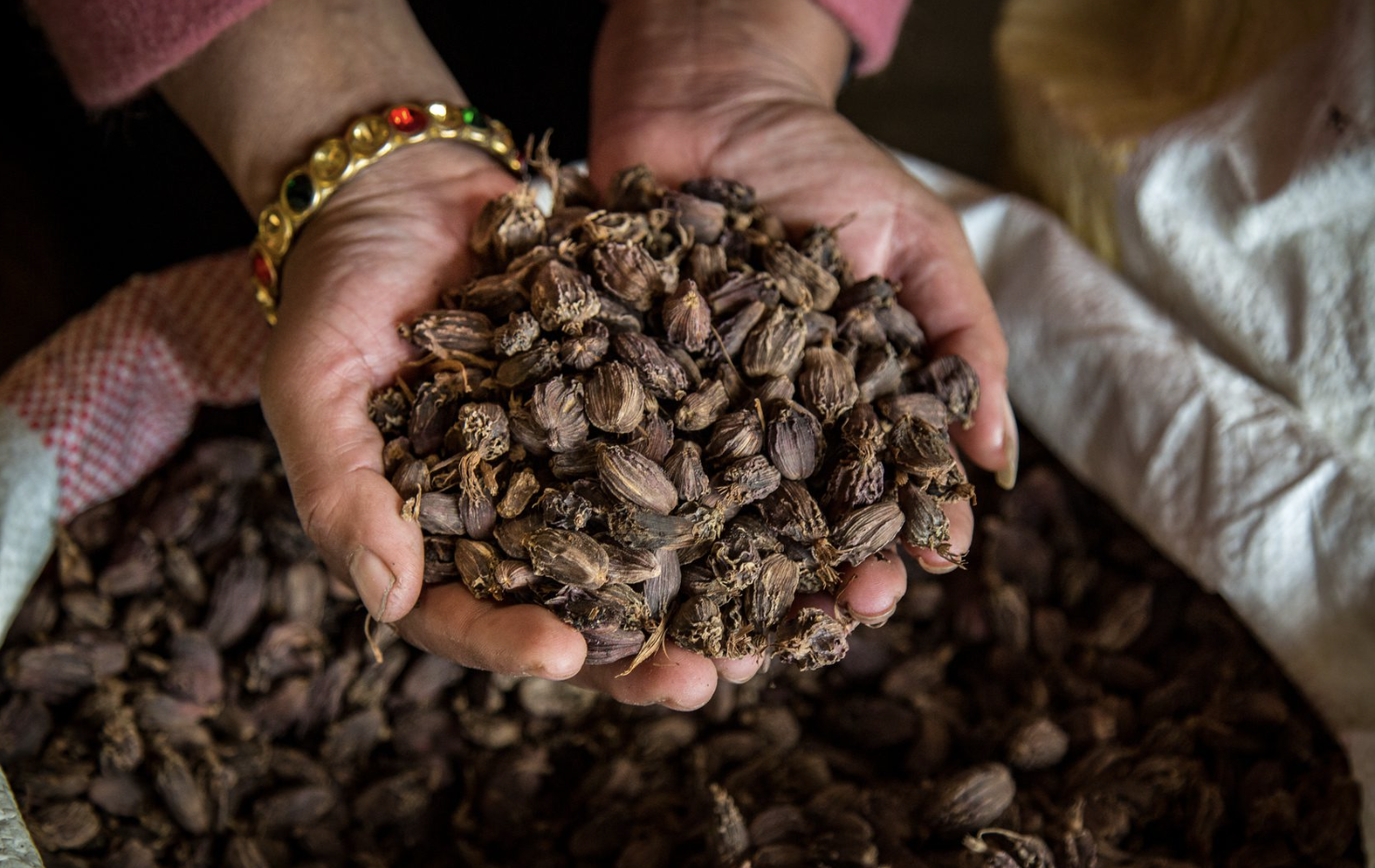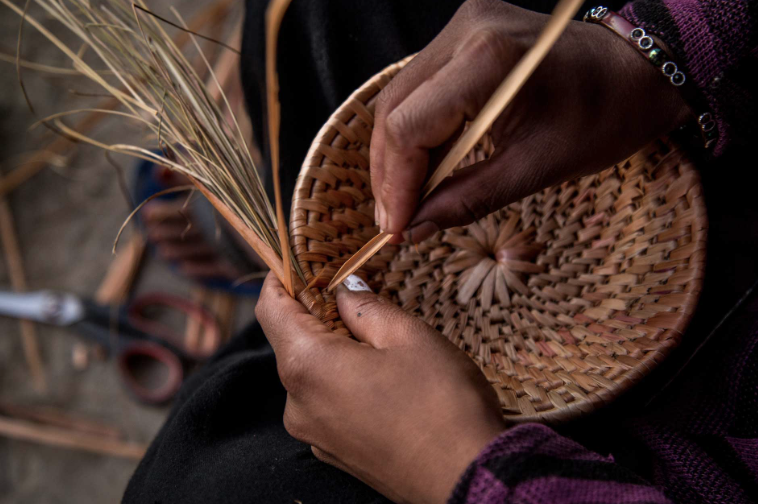Reviving and sustaining large cardamom production in Nepal

Summary
There has been increasing demand for large cardamom in global markets. However, climate change and its impacts have made cardamom farming difficult and expensive. Farmers are facing drought, increase in pests and disease infestation, erratic rainfall patterns, and unpredictable hailstorms and snowfall. Traditional farming methods have not been able to cope with these new challenges and yields have started to decline. By adopting climate resilient farming practices, creating value added cardamom-based products and diversifying their crops, large cardamom farmers can hope to sustain production and also improve their incomes.
Large cardamom (Amomum subulatum) is a high value cash crop and a major source of cash income for farmers in the eastern Himalayan region, including eastern Nepal; Sikkim and parts of Darjeeling and Kalimpong districts in West Bengal, India; and Southern Bhutan. Given its high value, farmers are able to make substantial profits even with the production and sale of small quantities of cardamom. Nepal is the biggest producer of large cardamom in the world, with a 68% share of the global market.
Most large cardamom farmers rely solely on this crop for their livelihood, making them more vulnerable when production fluctuates, or market prices drop. For instance, in 2014, the price of cardamom capsules reached USD 28 per kg, but dropped to USD 10 per kg in 2017. This drop in price heavily affected the farmers, as most farmers were solely dependent on income from the crop.
Given that Nepal produces the largest share of the world’s large cardamom, there is a pressing need for more sustainable production practices to revive and sustain large cardamom farming in the region.
Overview
- Location:
- Implementation sites:
-
- Single country
- Single location
- Mountain region:
-
Himalayas
- Province:
-
- Taplejung District
- Solution scale:
- Ecosystem type(s):
- Solution type(s):
- Sector(s):
- Climate impact(s) addressed:
- Other climate impact(s) addressed:
-
- Erratic rain and snowfall
- Climate impact time-scale(s):
- Main benefit associated with the solution:
- Co-benefit(s) associated with the solution implementation:
- Implementation timeline:
-
- 2012 - 2018
- Sendai targets:
-
Solution details
Main beneficiaries & outcomes
The pilot project on large cardamom value chain development in Taplejung increased (almost doubled) yields by adopting a climate-resilient package of practices; promoted cardamom-based value-added products under the Himalica brand in domestic markets, cardamom-based products from fibre, intercropping kiwi, shitake mushroom with cardamom, cultivation of off-season vegetables in poly houses; promoted bee pollination in large cardamom farms, and spice garden tourism with homestay.
The project is benefitting 288 households in Phungling, Furumbu, and Sikaicha areas, mobilizing 12 farmers’ groups and one cooperative spread over areas situated at 900–2100 masl. Climate-resilient practices on large cardamom – related to soil/nutrients, water, energy, gender, knowledge, and weather have been piloted and promoted in Taplejung.
Furthermore, more than 400 households in Taplejung have adopted the package of practices. Early results indicate that the practices have improved soil structure, soil water-retention capacity and soil aeration, which have led to a better microclimate. Large cardamom production in the region has also started to increase. While traditional farming yielded 350 gm of dried cardamom capsules per clump, the newer practices have resulted in 750 gm of dried capsules per clump.
Entrepreneurs in Taplejung are now using cardamom as the main ingredient for products such as cardamom powder, cardamom tea, and biryani masala. The cardamom stalks are also being use to weave bags, purses and placemats that can be sold as souvenirs in Kathmandu and beyond. The products are promoted and sold under the brand “Himalica: Products from mountain people”.

Planning and implementation
ICIMOD’s pilot project ‘Support to Rural Livelihoods and Climate Change Adaptation in the Himalaya – Himalica’, a demand-driven programme funded by the European Union (2012-2018) helped build resilience in the cardamom production system in Taplejung, Nepal, the country’s largest cardamom producing district, by promoting simple and affordable practices. In recent years, large cardamom farmers in the district have been facing a reduction in yield due to viral diseases and poor soil conditions. In partnership with the Environment Conservation and Development Forum (ECDF), ICIMOD encouraged farmers in the region to diversify their income by incorporating other horticulture crops and livestock in the farming system, as well as helping them add value to their produce after harvesting.
Building on, and considering knowledge on local farming, Himalica introduced different resilient technologies and practices that farmers could easily adopt with locally sourced material. The solution developed a Package of practices (PoP) to promote climate-resilient cardamom value chain in Nepal with the following practices:
- Weather-smart practices, which include alteration of planting time and the planting of recommended local varieties that are resilient to extreme weather conditions, assessment of rainfall requirements, snowfall and frostbite in cardamom and measures to cope with these problems.
- Soil/nutrient-smart practices, which include production and application of manures, compost production, green manure, inter-crops, weeding, etc. to maintain soil health/organic matter.
- Knowledge-smart practices, which focus on strengthening linkages and making information available to value chain actors on – soil type, slopes/aspects, disease and pest management, market price, demand-supply, and business development services.
- Water-smart practices, which focus on effective and efficient use of water at different stages of value chain, highlighting technologies that farmers should apply to ensure water availability – irrigation, mulching, shade, etc.
- Energy-smart practices, particularly for harvesting/post-harvest management

To ensure that the farmers do not have to rely solely on the production of large cardamom for their livelihood, they were encouraged to pursue additional, alternative sources of income such as –
- Beekeeping to improve pollination in large cardamom fields and sell the honey
- Cultivating kiwi for shade, along with it being a high-value secondary crop
- Mushroom cultivation on the cardamom forest floor as an additional crop
- Raising livestock in the cardamom farming system
Furthermore, instead of only selling cardamom pods at lower costs, SABAH (SAARC Business Association of Home-Based Workers) was brought in to develop potential products using large cardamom as raw material. Communities in Taplejung received training to make these products.
Finance
The Himalica project was financed by the EU.
Innovation
By creating value-added cardamom-based products and diversifying their crops, cardamom farmers can hope to sustain production and also improve their income.
Capacities for design and implementation
Technology
As part of the Himalica project, an SMS service was initiated, targeting 225 farmers in Taplejung. The SMS service included information on market price, weather, and agriculture advisory services for sustainable production of large cardamom. Farmers can also call cardamom experts in case of problems. Thus, the availability and use of mobile phone technology was one of the key factors contributing to the success of this solution.
Socio-cultural
Local communities have been heavily involved in the implementation of this project; from receiving training on how to make alternative cardamom products to diversify their income to mobilising farmers’ groups to increase knowledge and best-practice sharing opportunities.
Outlook & Scalability
Potential for upscaling and replication
Convinced by the success of the pilot, the National Spice Crop Development Programme of the Department of Agriculture, Nepal, collaborated with us to co-publish a manual in Nepali titled ‘Resource Book for Farmers: Climate-Resilient Practices for Sustainability of Large Cardamom Production Systems in Nepal.’ The manual has also been published in English in partnership with The Mountain Institute, Sikkim, and Sikkim Agriculture Development Bank. This could foster knowledge sharing and learning on the topic of making cardamom production more climate-resilient and sustainable in the long-term; in turn, increasing the likelihood of the solution being replicated in other agricultural areas.
The newly elected representatives of the Fungling Municipality in Taplejung, Nepal, also invited ICIMOD to support them in developing their plans for sustainable development of agriculture, with a particular focus on large cardamom.
- Climate change and security in Nepal: Pilot intervention
- Women-centric approach to enhance resilience in Kavre district, Nepal
- Reducing vulnerability and increasing adaptive capacity in agriculture sector in Nepal
- Support for Sustainable Food Production and Enhancement of Food Security and Climate Resilience in Burundi's Highlands




Comments
There is no content